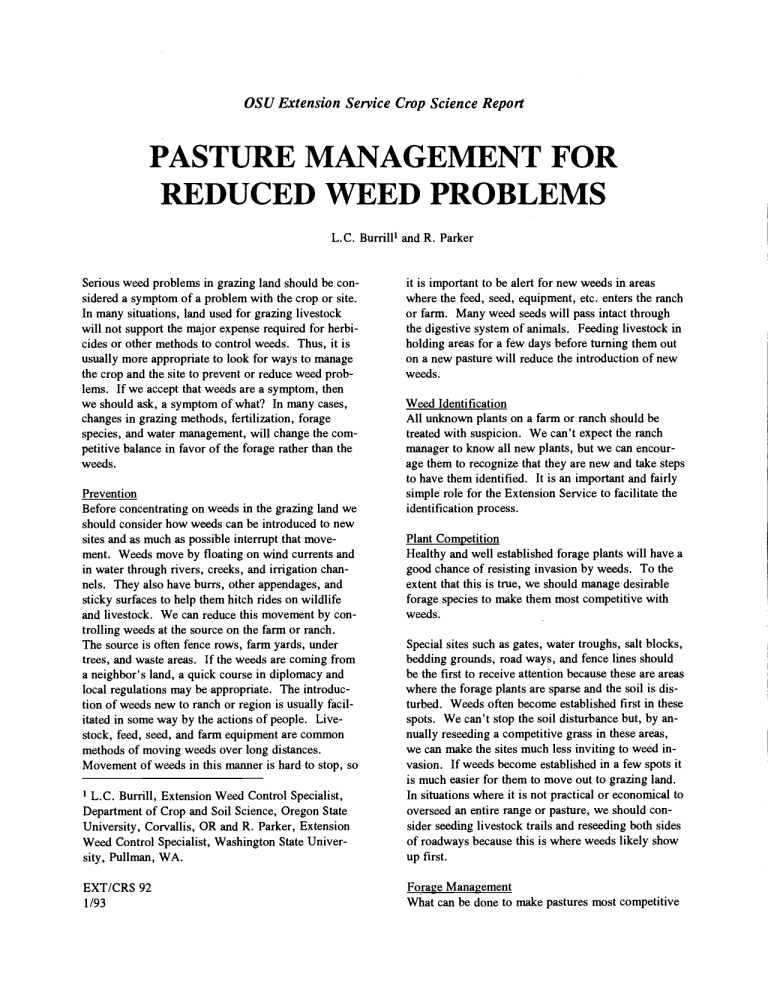PASTURE MANAGEMENT FOR REDUCED WEED PROBLEMS OSU Extension Service Crop Science Report
advertisement

OSU Extension Service Crop Science Report PASTURE MANAGEMENT FOR REDUCED WEED PROBLEMS L.C. Burrillt and R. Parker Serious weed problems in grazing land should be considered a symptom of a problem with the crop or site. In many situations, land used for grazing livestock will not support the major expense required for herbicides or other methods to control weeds. Thus, it is usually more appropriate to look for ways to manage the crop and the site to prevent or reduce weed problems. If we accept that weeds are a symptom, then we should ask, a symptom of what? In many cases, changes in grazing methods, fertilization, forage species, and water management, will change the competitive balance in favor of the forage rather than the weeds. Prevention Before concentrating on weeds in the grazing land we should consider how weeds can be introduced to new sites and as much as possible interrupt that movement. Weeds move by floating on wind currents and in water through rivers, creeks, and irrigation channels. They also have burrs, other appendages, and sticky surfaces to help them hitch rides on wildlife and livestock. We can reduce this movement by controlling weeds at the source on the farm or ranch. The source is often fence rows, farm yards, under trees, and waste areas. If the weeds are coming from a neighbor's land, a quick course in diplomacy and local regulations may be appropriate. The introduction of weeds new to ranch or region is usually facilitated in some way by the actions of people. Livestock, feed, seed, and farm equipment are common methods of moving weeds over long distances. Movement of weeds in this manner is hard to stop, so 1 L.C. Burrill, Extension Weed Control Specialist, Department of Crop and Soil Science, Oregon State University, Corvallis, OR and R. Parker, Extension Weed Control Specialist, Washington State University, Pullman, WA. EXT/CRS 92 1/93 it is important to be alert for new weeds in areas where the feed, seed, equipment, etc. enters the ranch or farm. Many weed seeds will pass intact through the digestive system of animals. Feeding livestock in holding areas for a few days before turning them out on a new pasture will reduce the introduction of new weeds. Weed Identification All unknown plants on a farm or ranch should be treated with suspicion. We can't expect the ranch manager to know all new plants, but we can encourage them to recognize that they are new and take steps to have them identified. It is an important and fairly simple role for the Extension Service to facilitate the identification process. Plant Competition Healthy and well established forage plants will have a good chance of resisting invasion by weeds. To the extent that this is true, we should manage desirable forage species to make them most competitive with weeds. Special sites such as gates, water troughs, salt blocks, bedding grounds, road ways, and fence lines should be the first to receive attention because these are areas where the forage plants are sparse and the soil is disturbed. Weeds often become established first in these spots. We can't stop the soil disturbance but, by annually reseeding a competitive grass in these areas, we can make the sites much less inviting to weed invasion. If weeds become established in a few spots it is much easier for them to move out to grazing land. In situations where it is not practical or economical to overseed an entire range or pasture, we should consider seeding livestock trails and reseeding both sides of roadways because this is where weeds likely show up first. Forage Management What can be done to make pastures most competitive with invading weeds? There is nothing new here. We are simply talking about doing whatever is reasonable to promote the forage. This is crop management, not weed management. If we concentrate on controlling weeds we do not necessarily see an increase in forage yield. As a general rule, every unit of weeds produced reduces forage by an equivalent amount. If we use available resources to make the crop grow better, a yield increase can be expected and the impact of weeds should be lessened. It is important that the forage species and variety be carefully selected for the site and the objectives. With that accomplished, the normal forage management decisions must be made and implemented. Fertility, soil pH, irrigation or drainage, grazing management, mowing, and periodic overseeding all have potential to influence crop growth and ability to compete with weeds. Anything that can be done to promote forage production will decrease weed invasion. Pasture Renovation When the forage on grazing land deteriorates to a point, the manager must decide on how to best correct the situation. On land where tillage is feasible, it is tempting to start over by plowing or disking and preparing a new seedbed. This may be the best alternative, but more often it just exposes a lot of new weed seeds to an environment favorable for germination. The land is out of production for several months and nothing has been done to prevent the deterioration again. Increased soil erosion and the relatively high cost are additional disadvantages of complete renovation. It may be a better option to simply overseed the pasture by the method most suitable for the situation. There are several types of no-till planters and techniques that may be suitable. If the seed is simply spread on the soil surface, it will help to irrigate, run livestock over the field for a few days, or harrow the field to move the seed into contact with the soil. Broadcast seeding spreads the seed over the entire area, which should be more competitive with weeds than drilling in rows. No-till planting has the obvious advantages of not taking the field out of production for a long period and there is no soil disturbance to expose new weed seeds to conditions for germination. Extra seed is recommended when the broadcast method is used. In certain situations it may be appropriate to feed seeds of desirable species to the livestock so that the seed will be planted in inaccessible areas after passing through the animals. Certain grasses and most smallseeded legumes remain viable after going through the animal's digestive system. Weed Control There are times when direct action on weeds is advisable. 1. Weeds that are new to a farm and few in number should be controlled with a shovel, a herbicide, or another appropriate method before they become established. 2. Poisonous plants can cause livestock losses that are unacceptable. In grazing areas that are small enough and accessible, control programs should be implemented. Fencing might be appropriate in serious cases, but herbicides or shovels are good tools when plants are widespread and relatively few. Poisonous plants frequently are the first to appear in the spring. Delay introducing livestock into these areas until adequate forage is available, and do not overgraze. 3. Certain perennial weeds cannot be discouraged by competition from vigorous forage plants. Herbicides, physical removal, or tillage are common methods, but incorporation of different animals such as goats or sheep may be an effective option. 4. If weeds have become so dense and the forage species so thin to make the site unprofitable, the use of herbicides or tillage may be the best option. This should be done only when necessary. Summary By directing management and resources to promote growth of forage species they will be more able to compete with weeds. This concept is helpful in correcting certain weed problems and in slowing or preventing invasion by new weeds. Careful use of herbicides can be a useful tool for forage management but is rarely cost effective for entire fields. Livestock management follows closely behind management of the forage sites in overall importance. The best chemical for forage production is probably fertilizer. Herbicides for Pastures Approximate Costs L. Burrill, 1992 Range of Name Rate Rate Used to Calculate Cost/A Concentration of product in lbs ae/gal Price/unit Cost/A 2,4-D Amine .7 to 2.8 lbs ae/A 1 lb. 4 $11/gal $2.75/A Banvel .25 to 8.0 lbs ae/A .5 lb. 4 $75/gal $9.37/A Crossbow spot or up to .5 gal 2 lbs 2,4-D + $48/gal $24/A $16/gal $6/A 1 lb triclopyr 1 gal/A MCPA Amine 1 to 2 lbs ae/A 1.5 lb. Escort/Ally .10-.75 oz. product .3 oz. Stinger .66-1.3 pt. 1.0 pt. 3 $514/gal $64.25 Curtail 2-4 qts. 2 qt. .38 lb Stinger + 2.0 lbs 2,4-D $33/gal $16.50/A 2 qt. 1 lb dicamba + 2.87 lbs 2,4-D $29/gal $14.50/gal Weedmaster 4 $29.50 oz. $8.85/A Herbicide Effectiveness on Weeds in Western Oregon Pastures Stanley W. Fultz, John Williams, Larry C. ilurrill sl F '111 .i.: E. 2,4-D Ester MCI'A tlicantba llanvel &maim + 2,4-D Weedmaster P P P P P G qi 0, a, P., 2,4-I) Amino pp ) gg R. o . n W*.21 -t) 00 V Nag o w.c? .5., 543 bl 5. ,ti del 0 ,-- F F G P P P p P P a pi V Q3 8 3 '4 R. I ... R, co F F G F F G GP P GP P P P G P p G F F F F PP P P G F F F F P W A' yr' 2 Grazing Restrictions' (In days unless otherwise indicated) %-iP. G G F P P F F N/A Lactating Non-lactating Slaughter b 7 Lactating Non-lactating Slaughter b 7 Lactating Non - lactating Non-lactat Slaughter 7-60 0 30 7 30 7 3 7 3 P . E G E G E G E G Lactating Slaughter b E Lactating Non-lactating Slaughter ' Spot treatment I <Da% oichwyr + 2,4-D Crossbow P cloilyralid Stinger glyltosate Roundup atetsulfarott Ally/Escort Relative Control F G P F FN/AF P E p G F F N/A F E F E = Excellent (95-100%) N/A N/A P P F N/AF E E G = Good (80-94%) GF P G PPG P P / F P P F = Fair (60-79%) E N/A N/A P N/A G N/A 14 3 0 0 Broadcast Spot treatment 8 weeks 14 0 N/A = No Information Available ' As %veili all pesticides, read and follow the label directions. Other restrictions may apply. b Cattle should be removed from treated area this many days before slaughter. 1 year 7 E P = Poor (less than 59%) >lilac 14 6/92





